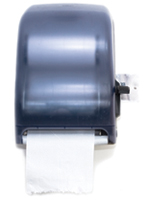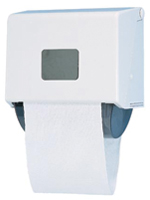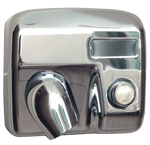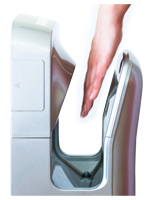What's greener?
What's the greenest way to dry your hands?
Andrew Mackintosh

It’s something we do several times each day – hopefully! – yet we don’t often think about the environmental impact of drying our hands. Is it better to cut down trees for paper towels, use re-washable cotton reels, or use electricity to power air dryers? Each option has its drawbacks, but if you’re wondering which system to install, then there’s one choice that’s clearly better for the environment.
Paper towels

|
| Made from wood pulp, these can include anywhere between 0 and 100 per cent recycled content. |
|
| The biggest impact of this system comes from making the paper (growing trees, plus the heavily industrial pulp and paper process), while disposal, transport and bin liners also contribute. |
|
| Paper towels can’t normally be recycled as they’re considered to be contaminated after use. However, it is possible to compost them. |
|
| The equivalent of 18g of CO2 is emitted for each time you dry your hands (using two towels). |
Cotton reels

|
| A reel of cotton inside a cabinet gives you a fixed length of clean towel to dry your hands on with each pull. |
|
| Growing cotton conventionally uses large volumes of agrichemicals. |
|
| Cotton reels can be reused 70-130 times before they wear out. |
|
| However, each time they’re reused cotton reels are washed, which requires significant amounts of water, energy and cleaning chemicals. |
|
| Once they’ve worn out, cotton reels are often cut up and used again as rags. |
|
| The equivalent of 9.3g of CO2 is emitted for each time you dry your hands (one pull). |
Hot-air dryers

|
| These dry your hands by evaporating the water with heated air. |
|
| Raw materials, manufacture, transport and disposal only account for about 5 per cent of the environmental impacts of these machines. The main impact comes from the electricity that powers them, which in New Zealand is a mostly renewable resource with low CO2 emissions. |
|
| The equivalent of 12g of CO2 is emitted for each time you dry your hands (30 seconds). |
Cold-air ‘blade’ dryers

|
| This recent technology uses high-speed air ‘blades’ to scrape the water from your hands, meaning the air doesn’t need to be heated. |
|
| Raw materials, manufacture, transport and disposal only account for about 5 per cent of the environmental impacts of these machines. The main impact comes from the electricity that powers them, which in New Zealand is a mostly renewable resource with low CO2 emissions. |
|
| The equivalent of 3g of CO2 is emitted for each time you dry your hands (12 seconds). |
The verdict – what’s greener?
Cold-air ‘blade’ dryers are by far the greenest option – followed by hot air dryers and cotton reels. Disposable paper towels have the worse environmental impact of all the methods. If you have to use paper towels insist on a brand that carries FSC, PEFC or ECNZ certification, which ensures the trees they’re made from were grown sustainably.
Have an eco dilemma that needs expert advice? Email [email protected] with ‘My dilemma’ in the subject line, or write to Green Ideas, PO Box 47177, Ponsonby, Auckland 1144.


